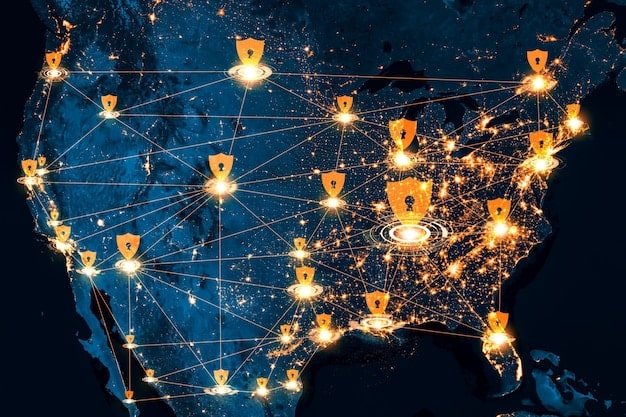Critical Infrastructure Protection: Are US Systems Ready?

Critical infrastructure protection (CIP) in the U.S. faces ongoing cybersecurity challenges, necessitating enhanced strategies, updated technologies, rigorous testing, and collaborative efforts to defend against evolving cyber threats and ensure the resilience of essential systems.
The specter of cyberattacks looms large over the United States’ critical infrastructure. Is the nation truly ready to defend against and withstand the next major assault on its essential systems? Critical infrastructure protection requires constant vigilance and innovation.
Understanding Critical Infrastructure in the US
Critical infrastructure encompasses the assets, systems, and networks that are essential to a nation’s security, economy, and public health. In the United States, this includes sectors such as energy, water, transportation, healthcare, and communications. These systems are increasingly reliant on digital technologies, creating vulnerabilities that can be exploited by malicious actors.
The interconnected nature of critical infrastructure means that a successful cyberattack on one sector can have cascading effects on others. For example, a disruption to the energy grid could impact water treatment facilities, transportation networks, and even healthcare providers. This interconnectedness underscores the importance of a holistic approach to cybersecurity, one that addresses vulnerabilities across all sectors.
Key Sectors of Critical Infrastructure
Several sectors are particularly vital and attract constant attention from both government and private security experts.
- Energy: Power grids, oil refineries, and natural gas pipelines are essential for maintaining daily life and economic activity. Cyberattacks targeting these systems could lead to widespread blackouts and energy shortages.
- Water: Water treatment and distribution systems provide clean water for drinking, sanitation, and industrial use. Disruptions to these systems could have severe public health consequences.
- Transportation: Airports, railways, and roadways are critical for the movement of people and goods. Cyberattacks targeting these systems could cause travel chaos and economic disruption.
- Healthcare: Hospitals, clinics, and healthcare networks rely on digital systems to provide patient care. Cyberattacks targeting these systems could compromise patient data and disrupt medical services.
Effective critical infrastructure protection requires a multi-layered approach, combining physical security measures with robust cybersecurity protocols. This includes regular risk assessments, vulnerability patching, and employee training.
The Evolving Cyber Threat Landscape
The cyber threat landscape is constantly evolving, with new and sophisticated attacks emerging regularly. Nation-state actors, cybercriminals, and hacktivists all pose a threat to critical infrastructure. These actors have varying motivations, ranging from espionage and financial gain to political disruption and ideological agendas.
Ransomware attacks have become a particularly pressing concern, as they can cripple critical systems and demand large ransoms for their restoration. Supply chain attacks, where malicious code is inserted into widely used software, also pose a significant threat. These attacks can compromise numerous systems at once, making them difficult to detect and mitigate.

Common Cyberattack Vectors
Understanding how cyberattacks are carried out is crucial to developing effective defenses.
- Phishing: Phishing involves sending deceptive emails or messages that trick users into revealing sensitive information or clicking on malicious links.
- Malware: Malware includes viruses, worms, and Trojans that can infect systems and steal data, disrupt operations, or grant unauthorized access.
- Denial-of-Service (DoS) Attacks: DoS attacks flood systems with traffic, making them unavailable to legitimate users.
- SQL Injection: SQL injection involves inserting malicious code into database queries to gain unauthorized access to data.
The challenges associated with protecting against cyber threats are compounded by the shortage of skilled cybersecurity professionals. Organizations often struggle to find and retain qualified personnel, leaving them vulnerable to attack.
Federal Efforts to Enhance CIP
The U.S. government has undertaken numerous initiatives to enhance critical infrastructure protection. The Department of Homeland Security (DHS) plays a central role in coordinating these efforts, working with federal agencies, state and local governments, and the private sector to improve cybersecurity across all sectors.
One key initiative is the National Institute of Standards and Technology (NIST) Cybersecurity Framework, which provides a set of guidelines and best practices for managing cybersecurity risks. The framework is widely adopted by organizations of all sizes and is regularly updated to address emerging threats.
Key Government Agencies Involved
Several federal agencies are involved in critical infrastructure protection.
- Cybersecurity and Infrastructure Security Agency (CISA): CISA is the lead federal agency for cybersecurity and infrastructure security, responsible for coordinating efforts to protect critical infrastructure from cyber and physical threats.
- Federal Bureau of Investigation (FBI): The FBI investigates cybercrimes and works to disrupt cyberattacks targeting critical infrastructure.
- National Security Agency (NSA): The NSA provides technical expertise and intelligence support to protect critical infrastructure from nation-state actors.
The government encourages information sharing between the public and private sectors, as this helps to improve situational awareness and facilitate faster response to cyber incidents. However, some organizations are hesitant to share information due to concerns about liability and reputational damage.
Private Sector Responsibilities and Challenges
The private sector owns and operates the majority of critical infrastructure in the United States. As such, private sector organizations have a significant responsibility to protect their systems from cyberattacks. However, they face numerous challenges in doing so, including limited resources, aging infrastructure, and a lack of skilled cybersecurity professionals.
Many organizations struggle to prioritize cybersecurity investments, particularly when faced with competing business priorities. Legacy systems, which were not designed with security in mind, can be particularly vulnerable to attack. Patching these systems can be difficult and disruptive, leaving them exposed to known vulnerabilities.

Enhancing Private Sector Cybersecurity
Private sector organizations can enhance their cybersecurity posture by:
- Conducting regular risk assessments: Identifying vulnerabilities and prioritizing remediation efforts.
- Implementing multi-factor authentication: Adding an extra layer of security to prevent unauthorized access.
- Providing employee training: Educating employees about phishing scams and other cyber threats.
- Developing incident response plans: Preparing for and responding to cyber incidents effectively.
Collaboration between the public and private sectors is essential for enhancing critical infrastructure protection.
The Role of Advanced Technologies
Advanced technologies play a crucial role in critical infrastructure protection. Artificial intelligence (AI) and machine learning (ML) can be used to detect and respond to cyber threats in real-time. These technologies can analyze large volumes of data to identify anomalous behavior and predict potential attacks.
Blockchain technology can be used to secure supply chains and prevent the introduction of counterfeit or malicious components. Encryption can be used to protect sensitive data both in transit and at rest. These technologies can help organizations to improve their security posture and reduce their risk of cyberattacks.
Emerging Technologies for CIP
Exploring new technologies to improve cybersecurity is paramount.
The Internet of Things (IoT) presents both opportunities and challenges for critical infrastructure protection. IoT devices can be used to monitor and control critical systems, but they also create new attack surfaces. Securing IoT devices is essential to preventing cyberattacks.
Quantum computing also poses a potential threat to cybersecurity. Quantum computers could break many of the encryption algorithms that are currently used to protect sensitive data. Organizations need to prepare for the quantum computing era by developing and deploying quantum-resistant encryption algorithms.
Building a Resilient Cyber Defense
Building a resilient cyber defense requires a proactive and adaptive approach. Organizations need to continuously monitor their systems for threats, patch vulnerabilities promptly, and test their incident response plans regularly. They also need to invest in employee training and education to ensure that everyone understands their role in cybersecurity.
Resilience also requires the ability to recover quickly from cyberattacks. Organizations need to have backup and recovery systems in place to restore critical functions in the event of a disruption. They also need to have communication plans in place to keep stakeholders informed during a cyber incident.
Key Point
Brief Description
Threat Landscape
Constantly evolving threats from nation-states, cybercriminals, and hacktivists.
Federal Initiatives
Government efforts to enhance CIP through agencies like CISA and NIST.
Private Sector Role
Private sector’s responsibility to protect critical infrastructure with limited resources.
Advanced Technologies
Use of AI, ML, and blockchain to improve cybersecurity defenses.
FAQ
What is critical infrastructure?
Critical infrastructure includes essential assets and systems for a nation’s security, economy, and public health like energy, water, and transportation. These sectors are increasingly vulnerable to cyber threats.
What are the main cyber threats to critical infrastructure?
Common threats include ransomware attacks, phishing, malware, and denial-of-service attacks from various actors like nation-states and cybercriminals. These threats disrupt vital services.
What is the US government doing to protect critical infrastructure?
The U.S. government, through agencies like CISA, develops frameworks like the NIST Cybersecurity Framework and encourages information sharing between public and private sectors.
How can the private sector improve cybersecurity for critical infrastructure?
Private sector organizations should conduct risk assessments, implement multi-factor authentication, train employees, and develop incident response plans to enhance their security.
What role do advanced technologies play in critical infrastructure protection?
Advanced technologies such as AI, ML, blockchain, and encryption enhance threat detection, secure supply chains, and protect sensitive data, improving overall cybersecurity defenses.
The need for more robust and adaptive security measures is clear. The challenges are significant, but with sustained investment, collaboration, and innovation, the United States can strengthen its critical infrastructure protection and defend against the evolving cyber threat landscape.
Read more content





